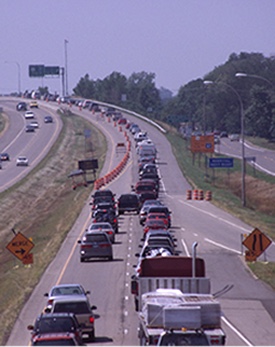 First question to ask is who is performing the merge? The vehicle that is moving from a side road to a main road is performing the merge and has the responsibility to merge without interfering with traffic. As the vehicle starts onto the access ramp they accelerate to the correct speed to fit into a gap in the traffic either increasing or decreasing their speed. The key word was their speed as the vehicle on the interstate is not the vehicle merging. When all of this works as planned it is an easy no stress experience for all involved.
First question to ask is who is performing the merge? The vehicle that is moving from a side road to a main road is performing the merge and has the responsibility to merge without interfering with traffic. As the vehicle starts onto the access ramp they accelerate to the correct speed to fit into a gap in the traffic either increasing or decreasing their speed. The key word was their speed as the vehicle on the interstate is not the vehicle merging. When all of this works as planned it is an easy no stress experience for all involved.
When the timid driver or the oblivious driver merges, they cause the flow of traffic to change as others either hit their brakes or speedup to let them in. The timid driver often stops making a dangerous situation as they then have to merge from a standstill causing the oncoming drives to often have to make a radical lane change or hit their brakes hard. The oblivious driver merges looking straight ahead and then moving to the left not looking to see if anyone is in that lane causing panic to others as they continue on not realizing the commotion they have caused. When reading an article, I had to laugh at one guy’s tactics with this type of driver as when he was beside them he would lay on the horn and watch the expression on their face as they swerved back to the shoulder. That expression has been seen by many truck drivers as this type of driver finally has to look and sees the steps of a truck. I also know of a lady driver who had a motorcyclist never look and drove into the side of her truck as he merged. She was found not to be at fault and the motorcyclist did live with only minor bruises. I have to imagine he will look the next time when merging.
Another form of merging that causes road rage is when there is construction and two lanes go down to one lane. Minnesota has this figured out with the zipper merge. What is a zipper merge? This is when everyone stays in their own lane until the point of going into the construction area and then take turns merging. This process keeps both lanes moving and has proven to be smoother and faster to get through construction areas then the one lane approach. This is a law now in Minnesota and a good one.
The zipper approach only works if traffic is moving slowly approaching the construction area and one lane of traffic. Studies that were done by Minnesota have shown that the zipper method can reduce the overall length of the traffic back up by 40%. This method also helps with road rage as each lane is moving and taking turns to merge or form the zipper.
During my driving career this is an area where I was prone to road rage after I have sat for sometimes hours in my lane waiting my turn and another vehicle zooms up to cut in front of me. A colleague watched a documentary about the zipper merge and that letting another vehicle in front of you really does not increase the wait time. I realized that he was right and all of my efforts to not let a vehicle in front of me and my stress level was not worth it.
Sit back, enjoy the view and be glad you are in a truck with all of the comforts instead of a smaller vehicle that can only see the vehicle in front of them and has no clue what is happening on down the road.
Being one of “those people” actually helps to keep traffic flowing.
Construction areas are part of our job as well as traffic jams, we can choose to fight the inevitable or sit back, smile, and relax. In other words, don’t worry be happy.
To learn more about the Minnesota Zipper Merge